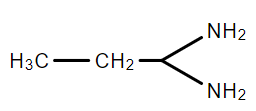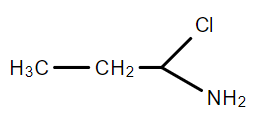
Answer
97.2k+ views
Hint: To answer this question recall the methods for the preparation of alkyne from dihalides. Sodium amide is a strong reducing agent which removes the halide atoms and generates an alkyne.
Complete Step by step answer:
We know that Sodium amide ($NaN{H_2}$) is a strong base and is used for deprotonation of weak acids and also for elimination reactions. Treatment of either geminal dihalide (two halogens on one carbon) or vicinal dihalides (halogens on adjacent carbons) with two equivalents of $NaN{H_2}$ results in the formation of alkynes.
Understanding the mechanism of this reaction is important: First, there is deprotonation of functional groups which is what is known as initiation of an elimination reaction. In this case, halide atoms are removed to form the alkene. Specifically, this is an example of an E2 (elimination 2) reaction.
Since the alkene still has a halide attached, this too can be removed to generate a second double bond (π bond).
The mechanism of this reaction can be shown as:

We can see from the above reaction that we receive an alkyne as the major product of the reaction.
Therefore, we can conclude that the correct answer to this question is option B.
Note: We should keep in mind the formation of terminal alkynes by use of this reaction mechanism. The acidity of terminal alkynes plays an important role in major product determination when dihalides undergo base induced elimination reactions. High electronegativity of the triple bond in terminal alkynes makes the molecule acidic. Therefore, one of the base molecules will pull off the terminal hydrogen instead of one of the halides like we desire to happen in this reaction. This implies that we would need three bases for every terminal haloalkane instead of two to obtain an alkyne.
Complete Step by step answer:
We know that Sodium amide ($NaN{H_2}$) is a strong base and is used for deprotonation of weak acids and also for elimination reactions. Treatment of either geminal dihalide (two halogens on one carbon) or vicinal dihalides (halogens on adjacent carbons) with two equivalents of $NaN{H_2}$ results in the formation of alkynes.
Understanding the mechanism of this reaction is important: First, there is deprotonation of functional groups which is what is known as initiation of an elimination reaction. In this case, halide atoms are removed to form the alkene. Specifically, this is an example of an E2 (elimination 2) reaction.
Since the alkene still has a halide attached, this too can be removed to generate a second double bond (π bond).
The mechanism of this reaction can be shown as:

We can see from the above reaction that we receive an alkyne as the major product of the reaction.
Therefore, we can conclude that the correct answer to this question is option B.
Note: We should keep in mind the formation of terminal alkynes by use of this reaction mechanism. The acidity of terminal alkynes plays an important role in major product determination when dihalides undergo base induced elimination reactions. High electronegativity of the triple bond in terminal alkynes makes the molecule acidic. Therefore, one of the base molecules will pull off the terminal hydrogen instead of one of the halides like we desire to happen in this reaction. This implies that we would need three bases for every terminal haloalkane instead of two to obtain an alkyne.
Recently Updated Pages
Write a composition in approximately 450 500 words class 10 english JEE_Main

Arrange the sentences P Q R between S1 and S5 such class 10 english JEE_Main

Write an article on the need and importance of sports class 10 english JEE_Main

Name the scale on which the destructive energy of an class 11 physics JEE_Main

Choose the exact meaning of the given idiomphrase The class 9 english JEE_Main

Choose the one which best expresses the meaning of class 9 english JEE_Main







